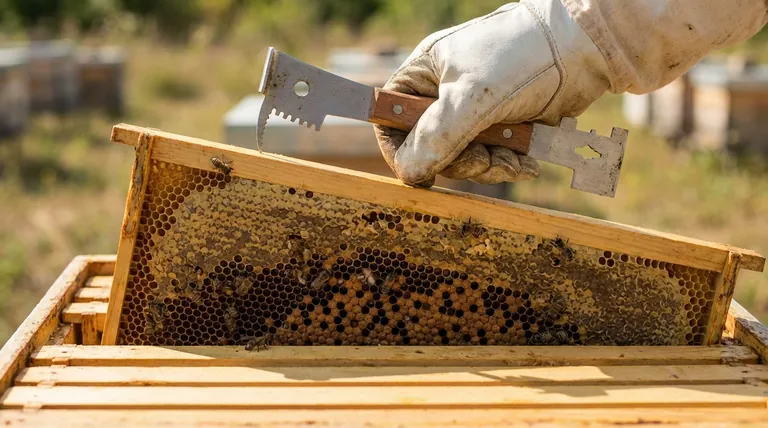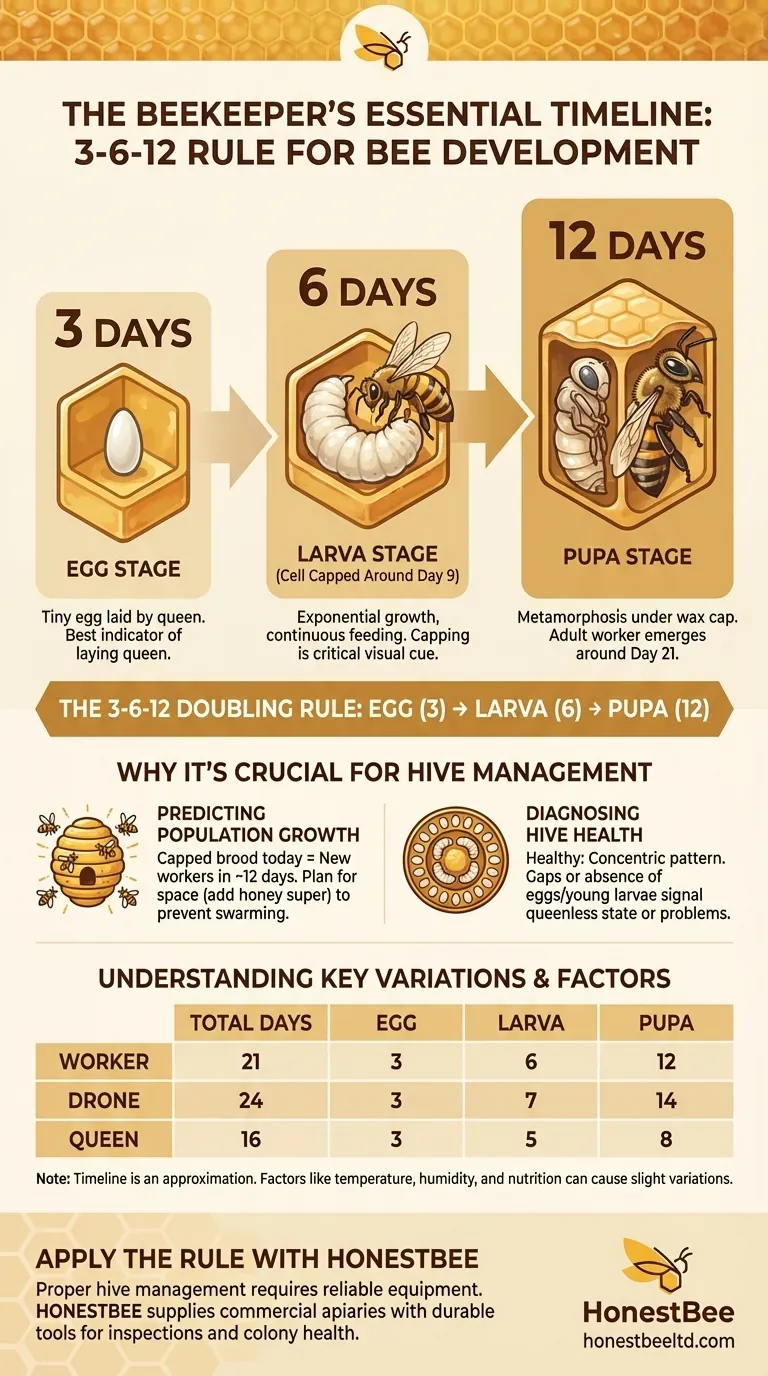To remember the bee development timeline, beekeepers use a simple doubling rule. A bee spends approximately 3 days as an egg, double that to 6 days as a larva, and double that again to 12 days as a pupa. This simple "3-6-12" mnemonic covers the roughly 21-day development cycle of a worker bee and is a foundational piece of knowledge for managing a healthy hive.
The core principle is simple: start at three days for the egg stage and double the duration for each of the next two stages. Mastering this timeline moves a beekeeper from simply observing bees to actively managing the colony's health and productivity.

The Three Stages of Bee Development
Understanding what happens during each phase gives context to the numbers and makes them more practical during a hive inspection. The "3-6-12" rule applies specifically to worker bees, which make up the vast majority of the colony.
The Egg Stage (3 Days)
The queen lays a single egg in the bottom of a wax honeycomb cell. For the first three days, it looks like a tiny, white grain of rice standing on its end.
Seeing eggs is the single best indicator of a healthy, laying queen, confirming she has been present and active within the last three days.
The Larva Stage (6 Days)
On day four, the egg hatches into a small, white grub called a larva. This is the primary eating and growth stage.
The larva is fed continuously by worker bees and grows exponentially. By the end of this stage (around day 9 total), the worker bees will cap the cell with a wax covering. This capping is a critical visual cue for the beekeeper.
The Pupa Stage (12 Days)
Once the cell is capped, the larva transforms into a pupa. This is the metamorphic stage where the grub develops its adult features: eyes, legs, wings, and internal organs.
This entire process happens out of sight, under the wax capping. After approximately 12 days in the pupa stage, a fully formed adult worker bee will chew her way out of the cell to join the colony.
Why This Timeline Is Crucial for Hive Management
This 21-day cycle isn't just trivia; it's a predictive tool that allows you to assess hive health and anticipate the colony's needs.
Predicting Population Growth
When you see a frame full of capped brood, you can predict a surge in the bee population will occur in about 12 days.
This allows you to plan ahead, ensuring the hive has enough space (by adding another honey super, for example) to accommodate the new bees and prevent swarming.
Diagnosing Hive Health
A healthy brood pattern shows all stages of development in a concentric pattern: eggs on the outside, then young larvae, older larvae, and capped pupae in the center.
Gaps in this pattern, or a "spotty" brood frame, can signal a problem. An absence of eggs and young larvae, for instance, is a strong sign the hive has been queenless for more than three days.
Understanding Key Variations
The "3-6-12" rule is an excellent guide for worker bees, but it's important to remember it's a model, not an absolute law.
Worker vs. Drone vs. Queen
The development timeline differs for each caste of bee.
- Worker Bee: 21 days (3 egg, 6 larva, 12 pupa).
- Drone (Male): 24 days. They have a longer pupa stage.
- Queen: 16 days. Her development is accelerated by a special diet of royal jelly.
Knowing these differences helps you correctly identify the type of brood you are looking at.
The "Capped Brood" Landmark
For practical purposes, the most important event is when the cell is capped around day nine.
When you see a capped cell, you know a new bee will emerge in about 12 days (for a worker). This is the most reliable visual for forecasting.
Environmental Factors
The timeline is an approximation. Slight variations can occur due to factors like the hive's internal temperature, humidity, and the availability of nutrients. A strong, warm, and well-fed colony may see slightly faster development.
Applying the "3-6-12 Rule" in Your Hive
Use this timeline as a framework for making decisions during your hive inspections.
- If you are checking for a laying queen: Look for eggs, which confirms she was active in the last 3 days.
- If you are estimating future foraging strength: A frame full of capped brood today means thousands of new workers will emerge in about 12 days.
- If you suspect a hive is queenless: An absence of eggs and larvae younger than three days is your strongest clue to start intervention.
Memorizing this simple timeline is the first step toward understanding the rhythm of your colony and managing it with confidence.
Summary Table:
| Stage | Duration | Key Event | Significance for Beekeepers |
|---|---|---|---|
| Egg | 3 Days | Egg is laid | Confirms queen was active within last 3 days |
| Larva | 6 Days | Cell is capped (around Day 9) | Critical visual cue; primary eating/growth stage |
| Pupa | 12 Days | Adult bee emerges (around Day 21) | Predicts population surge in ~12 days from capping |
Ready to apply the 3-6-12 rule with confidence? Proper hive management requires reliable, high-quality equipment. HONESTBEE supplies commercial apiaries and beekeeping equipment distributors with the durable tools needed for effective hive inspections and colony health monitoring. From hive tools to protective gear, our wholesale-focused operations ensure you have what you need to support your bees' 21-day development cycle. Contact our team today to discuss your equipment needs and keep your colonies thriving.
Visual Guide

Related Products
- Multi-Function Hive Tool with Integrated Hammer for Beekeeping
- HONESTBEE Classic Pry Bar Hive Tool with High Visibility Finish for Beekeeping
- Professional Frame Comb Fork and Lifter for Efficient Handling
- Professional Grade Foldable Beehive Handles
- HONESTBEE Heavy Duty All Metal Frame Wire Crimper Tool
People Also Ask
- What is the importance of understanding the function of each part of the beehive? Master Your Hive for a Thriving Colony
- What is the use of hive tool in beekeeping? The Essential Multi-Tool for Every Beekeeper
- How often should the area under beehives be inspected and cleaned during the warm season? A Proactive Maintenance Guide
- What are the alternatives to a hive tool? The Essential Tool for Every Beekeeper
- What are some essential tools for beekeepers? Start Your Apiary with the Right Gear



















